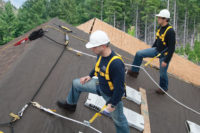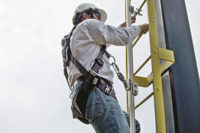| Myths about Confined Space |
| Myth 1 |
| Myth 2 |
| Myth 3 |
Make sure you have the facts about these three common confined spaces myths, and your employees’ safety will be better protected.
Myth #1: Falls aren’t an issue in confined spaces.
Workers at height require fall protection equipment for obvious reasons, but accidental falls can also occur in confined spaces. To determine if a confined space warrants the use of fall protection equipment, evaluate the access point as well as the actual confined space.
A manhole is one example of a confined space that doubles as a fall hazard. Lack of proper safety equipment places all workers at an increased risk of falling through the opening. As soon as the cover or hatch is removed, workers on the jobsite risk falling through the unguarded opening. Once within the confined space, the risk of falling further into the confined space often exists. Falls while entering and exiting are often a hazard based on the condition of the climbing structure, poor lighting and challenging space restrictions.
In some situations, fumes can trigger loss of consciousness, affecting workers entering the space and of others working near the area.
The use of fall protection products such as guardrails, barriers and self-retracting lifelines or lanyards is essential to prevent accidental falls or to stop them in progress. Restraint systems and barriers are designed to restrict a worker from reaching the edge of an opening, while fall arrest systems are designed to arrest the fall of worker.
Implementing a fall protection system reduces the risk of serious injury linked to accidental falls, even in confined spaces.
Myth #2: All confined spaces require a permit.
Cramped spaces occur in almost every jobsite, and safety should always be of the utmost concern. But only spaces meeting OSHA’s definition of a confined space and containing health or safety hazards require a permit.
To require a permit, OSHA says a confined space must meet one or more of the following conditions:
contains or has the potential to contain a hazardous atmosphere
contains a material that has the potential to engulf an entrant
has walls that converge inward or floors that slope downward and taper into a smaller area which could trap or asphyxiate an entrant
contains any other recognized serious safety or health hazard, such as unguarded machinery, exposed live wires or heat stress
If a worker will be accessing a confined space with any of these circumstances, the employer is responsible for developing a written safety program to comply with OSHA standards (1910.146).
A strong confined space safety program should be structured around one common goal: workers’ health. Specifically, the written program needs to discuss the means, procedures and practices used to eliminate or control hazards and ensure safe operations. In addition to preventative measures, the program should discuss air quality monitoring, exit and entry methods and fall protection/rescue systems.
Myth #3: Entry rescues are the first option in confined space rescues.
A successful rescue plan requires proactive planning and preparation. In preparing your rescue plan, designate capable personnel who can quickly perform the assigned rescue duties during an emergency. Then provide the designated personnel the proper training to execute a safe and effective rescue.
Always consider non-entry rescue as the first option. Deploying an entry rescue team often poses a greater danger to both the fallen worker and the rescuers. Entry rescues expose more personnel to the confined space’s hazardous conditions, ranging from oxygen deficient air to difficult entry and escape. Entry rescues endanger both the fallen worker and the rescue personnel if not managed properly.
Invest in proper safety retrieval systems and methods, such as full-body harnesses and mechanical retrieval devices, connect the entering workers to the devices before an entry is made, and have the top side personnel readily available to facilitate non-entry rescue.
Correcting common misconceptions about confined spaces is the first step to a safer, more informed workplace. As a safety professional, you are responsible for taking this knowledge and translating it into action. Take the time to recognize the importance of safety equipment, evaluate whether a formal written permit is needed and prepare a detailed rescue plan for emergencies.


